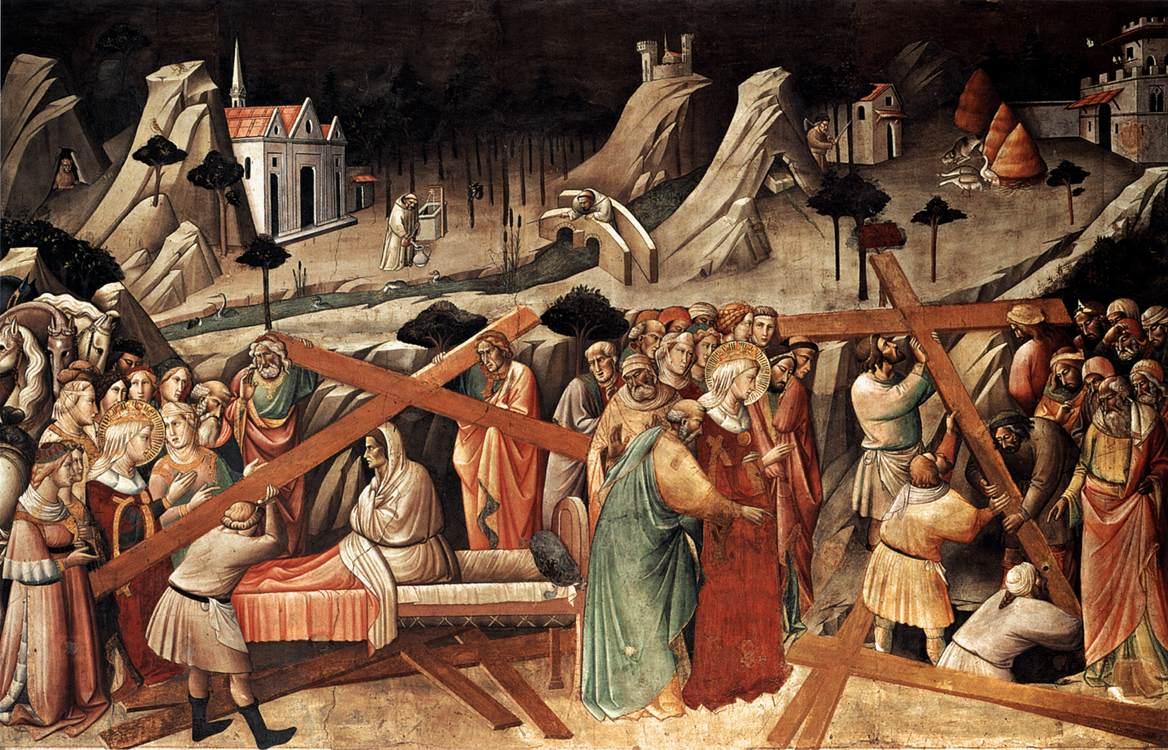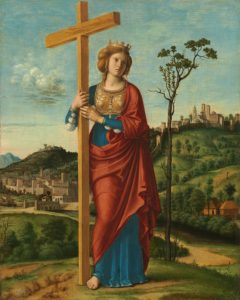
I saw glory’s tree honored with trappings,
shining with joys, decked with gold;
gems had wrapped that forest tree worthily round.
—from “The Dream of the Rood” trans. Jonathan A. Glenn (1982)

Many Christians celebrate the Feast of the Exaltation of the Holy Cross—also known as Holy Cross Day, Holy Rood Day, or Roodmas—each year on September 14th.Note 1 Holy Cross Day commemorates both the discovery of the True Cross in 320 A.D., and the anniversary of the dedication of the Church of the Holy Sepulchre in 335 A.D.1
Although this feast day was established at the end of the seventh century, its roots lie in the early fourth century, when Saint Helen embarked on a pilgrimage to Jerusalem in an attempt to discover the True Cross—the cross on which Jesus Christ was crucified.2

St. Helen’s Pilgrimage
St. Helen, who was in her sixties when she made her pilgrimage, had begun her life as a pagan but converted to Christianity in her later years, possibly due to the conversion of her son Emperor Constantine I (or vice versa). Constantine fundamentally changed the course of history in 313 A.D. with his issuing of the Edict of Milan, an agreement that gave full religious liberty to Christians.3 Prior to the Edict, Christianity had been illegal and Christians had been subjected to terrible persecutions.
According to the Greek historian Eusebius, at the time that St. Helen arrived in Jerusalem there was a pagan temple dedicated to Venus lying at the top of the hill of Calvary (otherwise known as Golgotha), the site where Jesus Christ was crucified. Helen ordered the pagan temple to be destroyed and an excavation to be undertaken at that location. Three crosses were discovered buried some twenty feet under the ground, but it was unclear which was the True Cross (two other men had been crucified alongside Jesus).4 Legend says that Helen touched each of the three crosses to the body of a terminally ill woman—the wood that healed her was identified as the True Cross.5 Helen took some fragments of the True Cross with her when she returned to Rome.
The Building of the Basilica
Emperor Constantine ordered the construction of the Church of the Holy Sepulchre on the newly-discovered site of Christ’s tomb, which was completed and dedicated on 14 September 335 A.D. The church was damaged by fire in the early seventh century and subsequently destroyed during the rule of the Fatimid Caliphate in 1009 A.D. Reconstruction began about twenty years later, and concern about the long-term safety of the church and the city of Jerusalem played a role in the crusades of the Middle Ages. Though the building and the city changed hands numerous times over the centuries, the Church of the Holy Sepulchre has always served as an important site for Christian pilgrims, and today it remains a popular landmark in Jerusalem for visitors of all faiths.6
Celebrate with Children
Holy Cross Day is a great opportunity to talk with children about Christ’s great love and life-giving sacrifice, and perhaps to discuss the cross as a Christian symbol. In our home we read a book called The Queen and the Cross: The Story of Saint Helen, written by Cornelia Mary Bilinsky and illustrated by Rebecca Stuhff, which tells the story of St. Helen’s journey to Jerusalem and what she found there. A fun craft might be to paint unfinished wooden wall crosses that the children can put up in their bedrooms. Although typically baked on Good Friday, hot cross buns are also a perfect food to prepare for Holy Cross Day.
I also love this simple prayer from The Queen and the Cross: “Dear Lord, help us to treasure your cross above all things, and honor it in all the small crosses you ask us to carry as we follow you.”
Hot Cross Buns
adapted from Cooks.com—quick and easy, no yeast involved!
Ingredients:
For the buns
1 c whole wheat or all-purpose flour
2 tsp baking powder
1/2 tsp salt
2 Tbsp butter
1 Tbsp honey
1/2 tsp cinnamon
1/4 c raisins
1/3 c milk
For the frosting
1/2 c confectioners sugar
2 tsp milk
1/4 tsp vanilla
Directions:
1. Preheat oven to 400 degrees F.
2. Mix flour, baking powder, and salt. Cut in the butter with a fork or pastry cutter until it looks like coarse crumbs. Add honey, cinnamon, and raisins and stir gently to mix. Make a well in middle and pour in milk. Stir quickly with a fork and form a ball.
3. Divide dough into 6 round buns and place on greased baking sheet. Cut a deep cross through the top of each bun. Bake for 15-20 minutes.
4. While buns are baking, mix together confectioners sugar, milk, and vanilla. When buns are done, let them cool slightly, and then apply frosting in the shape of a cross on the top of each bun.

NOTES
Note 1Rood, from Old English rōd, crucifix, pole
ENDNOTES
1 “Exaltation of the Holy Cross” by Fr. Don Miller, OFM, www.FranciscanMedia.org
2 “The Exaltation of the Holy Cross,” www.CatholicNewsAgency.org, 9/14/17
3 “313 The Edict of Milan”by David F. Wright, www.ChristianityToday.com
4 “The Finding of the Cross,” Christian Classics Ethereal Library, www.CCEL.org
5 “Helen,” The Illustrated World Encyclopedia of Saints by Tessa Paul (Lorenz Books, 2014), p 94
6 “Church of the Holy Sepulchre” www.ChurchoftheHolySepulchre.net
Clip art on this page created by elements © Jing Cheng, CornerCroft. All other images on this page licensed under CC BY 2.0.
